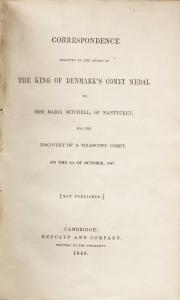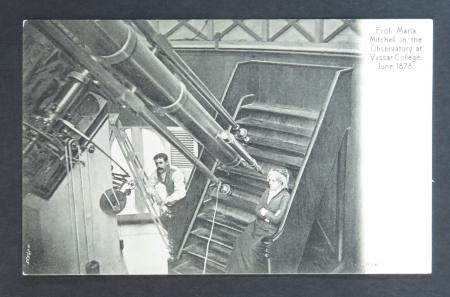 On the evening of October 1, 1847, while using a small telescope on the roof of the family home, Maria Mitchell (1818-1889) spotted a comet where one had not been before. Word of this achievement spread quickly through the scientific community. The American Journal of Science declared her “the first American entitled to the honor of the original discovery of a comet.” Some months later, thanks in part to Harvard College President Edward Everett, she received a gold medal from the King of Denmark, thus becoming one of the first Americans to win any sort of medal for science. She was unanimously elected an honorary member of the American Academy of Arts and Sciences, the first (and for many years the only) woman so honored. Newspapers termed her “The Lady Astronomer.”
On the evening of October 1, 1847, while using a small telescope on the roof of the family home, Maria Mitchell (1818-1889) spotted a comet where one had not been before. Word of this achievement spread quickly through the scientific community. The American Journal of Science declared her “the first American entitled to the honor of the original discovery of a comet.” Some months later, thanks in part to Harvard College President Edward Everett, she received a gold medal from the King of Denmark, thus becoming one of the first Americans to win any sort of medal for science. She was unanimously elected an honorary member of the American Academy of Arts and Sciences, the first (and for many years the only) woman so honored. Newspapers termed her “The Lady Astronomer.”
Mitchell was born to a Quaker family on Nantucket Island in Massachusetts. William, her father, introduced her to astronomy, encouraged her to serve as librarian for the local Atheneum, and supported her study of sophisticated scientific texts. The U.S. Coast Survey hired both father and daughter to make the astronomical observations needed to fix the location of Nantucket. The U.S. Nautical Almanac hired her to make astronomical calculations.
After the announcement of her discovery, Alexander Dallas Bache, Superintendent of the Coast Survey, praised “the lady astronomer in whose fame I take personal pride as having in some degree helped to foster the talent which has here developed . . . We congratulate the indefatigable comet-seeker on her success; is she not the first lady who has ever discovered a comet? The Coast Survey is proud of her connection with it.”
Joseph Henry, the founding Secretary of the Smithsonian, mentioned Mitchell’s achievement in his Annual Report for 1848, noting that the Smithsonian would soon publish an account of a new comet, “the discovery of which by an American lady is one of the first additions to science of this kind, so far as I am informed, ever made in this country.”

Henry’s actions exemplify the nineteenth-century’s ambivalent attitudes toward women scientists. At the American Association for the Advancement of Science meeting in 1856, Henry read a paper written by Mrs. Eunice Foote, prefacing it with a few words suggesting that “science was of no country and of no sex” and the “sphere of woman embraces not only the beautiful and the useful, but the true.” Such words were surely encouraging to Mitchell. On her first trip abroad, in 1857, Mitchell carried what she termed an “open sesame” -- “a letter given to me by Professor Henry, asking for me special attention from all societies with which the ‘Smithsonian’ at Washington is connected.”
In 1865, Mitchell became Vassar College’s first professor of astronomy, with keys to a handsome and well-equipped observatory. But all was not a bed of roses. “I shall see that tickets are sent to you for our Commencement week,” she wrote to Henry in 1869. “Can you not, for the sake of aiding us who are working hard to educate women thoroughly, come and see us—and—perhaps help us? I am sadly out of the reach of scientific people, and a visit from some one of the leading scientists would be very cheering.” In another letter, in March 1873, Mitchell asked “if there is any way by which endowments can be obtained. Our endowments at Vassar are wholly buildings and apparatus, and we Professors are crowded with tutors work.” “My only difficulty is to accomplish anything for science! My only consolation is that I have fine noble women among my students, whom I am training to open their eyes to the wonderful revelations of nature, and to receive the lessons into their heart.”

Mitchell was also a founding and active member of the Association for the Advancement of Women, an organization that discussed such questions of social science as education and temperance. The 1878 meeting would be in Washington, and Mitchell hoped to use a room in the Smithsonian for a few hours. “Even for so small a meeting,” wrote Mitchell to Henry, “it would help us in the eyes of many, who do not investigate, if we were under the roof of a building devoted to the diffusion of knowledge.” Henry agreed to her request, adding: “It would give Mrs. Henry & myself so much pleasure” to have you and your friends as “our guests during your stay in this city.”
Describing this trip to the Smithsonian in in her diary, Mitchell noted that Henry, then in his eightieth year, “has been ill and seems feeble, but he is still the majestic old man, unbent in figure and undimmed in eye. I always remember when I see him, the remark of Dorothy Dix, ‘He is the truest man that ever lived.’” “I asked him if a life of science was a good life, and he said that he felt it was so.” She obviously agreed.
Related Resources
Produced by the Smithsonian Institution Archives. For copyright questions, please see the Terms of Use.

Leave a Comment